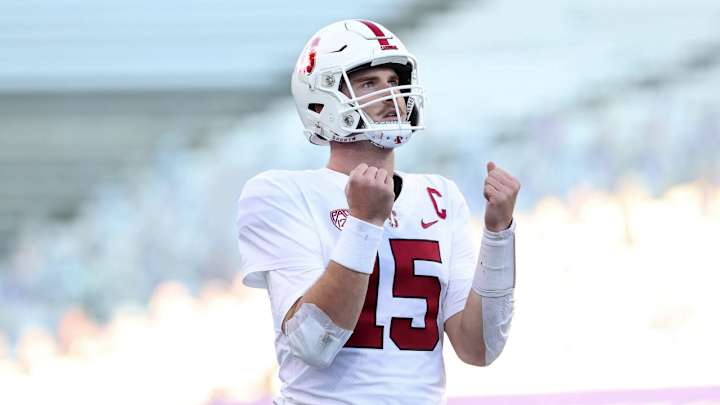Preaching About Reaching

The last in a series of BearDigest mock drafts is not due out until Sunday, BearDigest Mock Draft 6.0.
Sorry, stuff happens.
The speculation building around Bears interest in Stanford quarterback Davis Mills has led to plenty of discussion over how they actually could reach and make him the sixth first-round quarterback at No. 20 overall.
The thinking is Mills would be gone by No. 52, and if they find someone willing to trade down it might not put them in position to draft him anyway. There are teams like Tampa Bay, New Orleans and Pittsburgh who could take him toward the end of Round 1 after the Bears pick. Or some teams positioned in the middle or early second round could take him.
When you reach, there are ramifications.
So to satisfy the curiosity of what reaching to take a second- or third-round quarterback in Round 1 does to a team's draft, this special Davis Mills Reach Mock was conducted through the Pro Football Focus simulator. Call it Mock Draft 5.0-B.
What happened? Let's just borrow a line from the late Dennis Green and say the type of Bears drafted were exactly who we thought they would be.
The Bears were forced to accept less talented players at other positions.
Round 1, No. 20
QB Davis Mills, Stanford
The reach is on. PFF gave my pick a grade of D-minus. I made a hand gesture at them. This is the point of the mock.
I rewatched some game film on Mills over the weekend and saw his pro day workout in the rain when it was replayed on NFL Network. The way he stood up to the elements was commendable. The arm strength was not as bad as feared, but still not close to Kellen Mond or four of the first five quarterbacks. But he had a very wide assortment of throws and touch, good accuracy and his mobility is actually far better than the picture painted by some reports. Still, he's no first-round pick.
Round 2, No. 52
CB Elijah Molden, Washington
PFF labeled him a safety and there's thought he can do this. He's just a good coverage player and probably more of a slot cornerback than an outside corner. He's the best slot cornerback in the draft. Unfortunately, what happened here was every single other top cornerback had been taken by the 52nd pick. And guess what? Every single other viable tackle was off the board. In fact, all of the fastest slot receivers were gone except one who has a fourth- or fifth-round projection — D'Wayne Eskridge of Western Michigan.
This is exactly what will happen to the Bears if they reach for Mills in Round 1 and don't trade down for extra picks. If they do trade down, they might get burned in their attempt to land Mills.
It's a catch-22 situation and the ramifications of taking Mills continued right on through the remainder of this draft.
Round 3, No. 83
T Brady Christensen, BYU
The best tackle available at this point, but he's a left tackle and the ideal pick would be a right tackle because the Bears apparently are entrusting this position to Germain Ifedi. They also have Elijah Wilkinson to play there now, but neither one rates as an ideal right tackle. They'd probably both fit better at guard. Christensen is labeled a strong zone blocker, but doesn't have a long reach. He also needs to add some bulk because he comes in 6-6, 300 pounds. And he would be the replacement in 2022 for Charles Leno Jr. more than he would be a starter for 2021. Also, the other bad news is he's already 23 years old because he did a two-year Mormon mission.
While Christensen does have some flaws to his fundamentals, he was good enough to be Zach Wilson's blind-side protector and made first-team All-American last year. PFF had him at the end of last season as the No. 1 left tackle in the country. So it's not surprising they gave the grade of A- for this attempt to land a tackle after losing out on the best options earlier.
Round 5, No. 164
WR Simi Fehoko, Stanford
It was too soon to draft Eskridge in Round 3 at 83, even with his speed. Also, the tackle need was too great and there were too few tackles with ability remaining. So I had to take Christensen. But then came what will be a killer to the Bears draft even if they don't reach for Mills — the gap with no fourth-round pick. Eskridge got drafted in Round 4 and I still needed a speedy slot receiver since it's assumed Anthony Miller is getting dealt.
The best remaining option was Fehoko, but this helps in one way because he was Mills' receiver in college.
Fehoko is no mere slot or Z-receiver type. He has the size to be an X-receiver, if needed. He's 6-foot-4, 224 pounds. He's the height-weight equivalent of D.K. Metcalf, though lacking the ridiculous body-builder muscle. No one is doubting Fehoko's speed, and he ran 4.39 at the pro day in wet conditions. They did have the 40 area covered and one unofficial timer had him at 4.37. He's probably not the ideal slot, because his hands and route running are questions. His speed is real.
Round 5, No. 180
CB Shakur Brown, Michigan State
San Francisco took pity on my attempts to get back some of the weakness of this draft with my quarterback reach, as I tried to trade up out of Round 6 and successfully sent the 208th and 221st picks to John Lynch for No. 180 in Round 5.
There was one intriguing cornerback prospect available who could be on the outside or slot and has plenty of gumption. Brown is said by PFF to enjoy punishing opponents, and this can't be a bad thing at all on defense. He just isn't the most physically gifted cornerback and might bite on fakes too much to play the slot. That's OK. That's why I drafted Molden. Brown would compete for the open left cornerback spot with Desmond Trufant, Kindle Vildor, Artie Burns, Tre Roberson and the cast of thousands Ryan Pace has assembled to cover his rear end for losing Kyle Fuller.
Round 6, No. 204
TE John Bates, Boise State
This is a need position but probably not the ideal candidate for what the Bears need. He's not bad, though. Bates can do a little of everything. He can block, catch and run, and plays special teams. He's very athletic.He just isn't spectacular at anything and the ideal third Bears tight end for this year would be someone with the speed so they can learn the U-position or move-tight end spot. However, he was graded much, much higher than the 204th pick so it was someone who can help. The main reason for taking him here is no tackle candidate had the credentials sufficient for this spot.
Round 6, No. 228
T Robert Jones, Middle Tennessee State
The Bears have had a visit with him at the Senior Bowl according to Bear Report. This is an Illinois-raised player from Rockford (East) who is 6-5, 330 and size-wise projects as an ideal right tackle candidate. He just is completely short of seasoning against good competition and needs to work with line coach Juan Castillo for a year like Lachavious Simmons and Arlington Hambright did last year. He is a real fit for a zone scheme. The other possibility was a more highly graded tackle, Tommy Doyle of Miami of Ohio. However, the 6-8, 326-pound Doyle is considered a poor run blocker and not a fit in a zone blocking scheme by PFF.
The Draft Lesson Learned
There you have it, and PFF gave the effort a B to show it is possible to recoup some damage from reaching at No. 1.
However, the draft could look so much better at the top end with a more physical and technically sound tackle, a polished and faster slot recever, and premier lockdown cornerback.
None of this was possible by reaching at No. 20 for Davis Mills.
Twitter: BearDigest@BearsOnMaven
